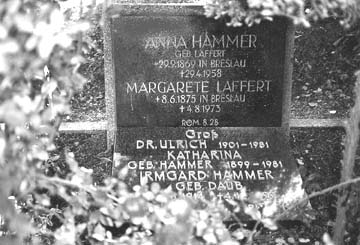A Box of Pictures from
the Past
Imagine,
a few years ago I found a cardbord box filled with dozens of old
photographs in my cousin Brigitte's attic. I poured its contents on
the dining table and let my eyes and hands shuffel through this
treasure: my grandmother Hammer in 1907, when she was 39, my mother
at 2 tucked into a sled pushed by Tante Gretel, the ravishingly
beautiful Hammer sisters Magda and Käthe at 19. And again and
again my archetypal Hammer-Grandmother from whom I inherited so
much.... I begged Brigitte, and she let me take them home.
We
lost all our pictures in the exodus from Habelschwerdt. By necessity
I have learned to live without such tangible memorabilia, keeping the
images I need in my mind, but to study the faces of these people with
a magnifying glass gave me a great, unknown pleasure. Then Eberhard
Schmidt, one of the cousins on my father's side, visited us in
California and presented me with another small box of photographs and
Xerox copies of our common grandparents Gross. There was my
statuesque grandfather, the pastor, God's nearest relative with his
white beard and his always grubby suit, and the "Grosse Käthe,"
Eberhard's mother and my father's sister, and dozens of pictures of
the 5 cousins - well-remembered from visits before the end of the
War....
Every
now and then I would pour these treasures out and look at them with
new eyes. How to share them with my children? A few nights ago - I
had spent a couple of weeks investigating my parents' psychological
makeup with an uncanny astrological computer program (believe it or
not!) - I woke up with the idea of restoring the pictures digitally
and put them on a website. And all these people came from their
graves and talked to me and walked through my dreams for several
nights. A compelling experience.
The
results of this labor of love you find below. There must be more
pictures in the possession of cousins and siblings: brother Dieter in
Berlin, who inherited many of my parents' possessions, must have
some, Fritz Hammer may own another set, Udo Hammer surly has more
pictures of his beloved mother Irmgard, Susanne rifled my treasure
once in a while. Would you let me borrow what I don't have and let me
add them to this collection? Maybe these things become only important
as one grows old....
Pacific
Palisades, September 2002-2005
Before
my Time
1900
- 1931
-
|
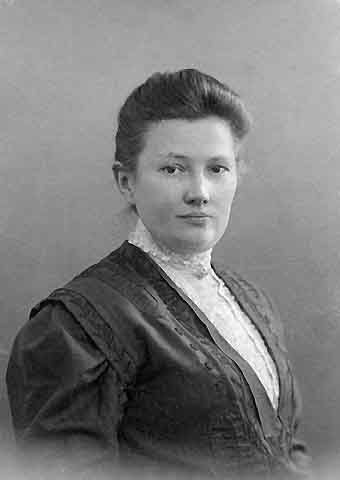
1907,
Königshütte, Oberschlesien. My Grandmother The
Family Matriarch, Anna Elisabeth Laffert-Hammer, born on
29 September 1869 to Robert Konrad Laffert and Agnes Krambs
who owned a hat-factory in Breslau. The Lafferts were French
Huguenottes who had fled to Prussia. Grandfather Friedrich
Hammer was a mining engineer who died in 1911 of pneumonia
leaving his wife and five children to the benevolent and
enlightened care of the owner of the mine.
|
|

1944(?), Frankfurt a/Oder,
Grandfather Gross, a reconstituted Xerox copy of a photo from
the last years of his life. With his white beard and stature he
was the effective Patriarch of our family: A protestant pastor,
he seemed to me, as a child, the closest image of God.
|

1906, Sakro, my Father Ulrich
and his sister Käthe
|
|

May 1915, , My father Ulrich
(14) as "Gymnasiast" in Görlitz. His Grandfather
was the director of the Gymnasium in Görlitz.
|

1917, Sakro(?), Ulrich and
Käthe Gross. Unfortunately this most charming picture of
the two is also a reconstituted Xerox copy, I cannot improve
contrast or definition
|
|

1915, Jannowitz, Grandmother
Hammer and her two strapping daughters on vacation
|

1901,
Jannowitz, Tante Grete Laffert, Anna's unmarried sister who
would outlive her, took care of the children and here pushes my
2-years-old mother, Käthe Hammer in the sled. Mother's
older brother Fritz and sister Magda look on.
|
|
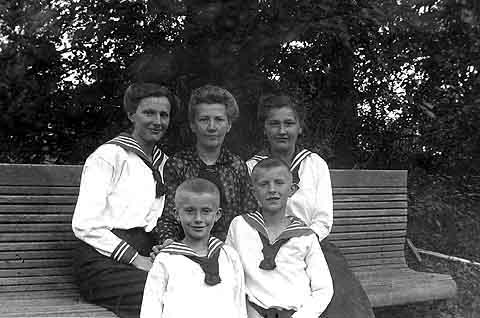
1917,
Janowitz, Grandmother Hammer with Magda, Kaethe, Gerhard and
Hans. Fritz was in the War
|

1917,
Janowitz, Hans, Gerhard, Kaethe, and Magda
|
-
|

1927,
Schweidnitz, My mother when father met her
|

1927-28, Schweidnitz, My
laughing mother.
|

1929,
Breslau, My mother in the year she got married

1929,
Breslau, Käthe and Ulrich's wedding in Grandmother Hammer's
apartment on the Clausewitz Str. A young friend with a guitare and
her brother, represent their Wandervogel group. Because of the great
magnesium flash everyone has their eyes closed except for Grandmother
Gross....
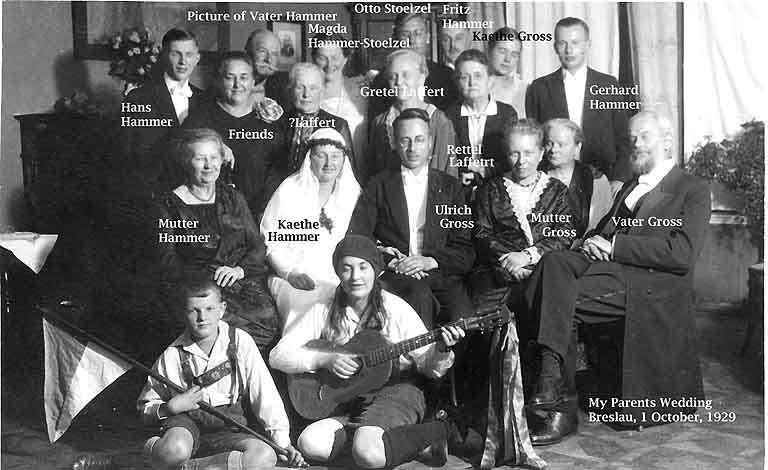
I
attached names to this gathering of the Hammer-Gross clan, so Susanne
can identify everyone! Some of their friends I don't know by name. -
On the wall behind the group hangs a picture of Grandfather Hammer.
Rolf's
Siblings and Cousins
1931-54
-
|

1931, Grünberg, My happy
Mother with her new-born Rolf at the hospital.
|

1931, Grünberg, Rolf's
baptism by Grandfather Gross at the house of friends whose
name I don't remember. Grandmother Hammer, my mother,
Grandmother Gross, an unidentified Patentante, godmother
(behind my mother), Father and Grandfather Gross in the
background.
|
|

1931 Grünberg, Rolf,
10-weeks old, tries to raise his head.
|

1931, Grünberg,
Grandfather Gross, who was not particularly fond of children,
tends to his grandson.
|
|

1933 Breslau (?) Rolf's first
pants
|

1933, Spring, Mother with R.
Grandmother Hammer used to keep this little circle on her desk
in Gelnhausen.
|
-
|
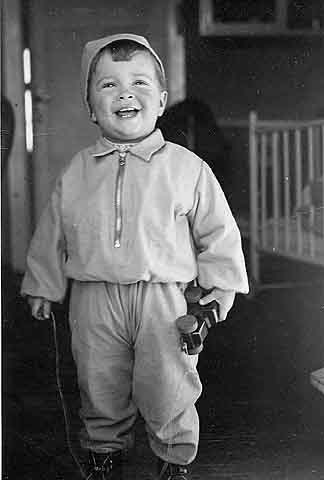
1933 Breslau, R. parked at
Grandmother Hammer's apartment during the time the Twins
were born
|

1934, Glatz, Father-Mother
and the Yardstick. The generations have grown taller over
the years!
|

1934,
Spring in Glatz in unserem Garten. In November 1933 the Twins,
Christine and Gerhard, had been born in Breslau and Father got a new
job at the Staatliche Landwirtschaftsschule (state-agricultural
trade-school) in Glatz. To obtain this position he had to be a member
of The Party. He satisfied this requirement by joining the
National-Socialist-Auto-Club - and in the next years wore a little
swastika-emblem on his lapel - which I only discovered when I
enlarged these old prints.... The Twins were growing fast and
seriously disturbed my relationship with Mother. You can see, how
could I compete against TWO? Increasingly I became the warden of the
two housemaids....
-
|

1934, Glatz, Christine and
Gerhard in our Garden
|

1934, Glatz, Gerhard and
Christine watching their older brother
|
1934-1937
Glatz
In
1934 father got a positon as teacher the Landwirtschafts Schule in
Glatz, a pticturesque town in the Grafschaft Glatz, hundred
kilometers south of Breslau. We moved into an old Gutshaus,
once the manor house of a minor, local nobleman, at thened of the
Herrenstrasse below the old barracks. There we lived until the end of
'37 when father was transferred to Habelschwerdt, 15 km further
south. Many of my early memories, Dieter's birth, the Einmarsch
(occupation) into the Sudetenland (1937), Kindergarten and my first
school year are connected with Glatz.
|

|
1936-37,
Glatz, the towers of the Church of the Minorite nuns, on whom I
spied on my way to school. Behind them the tower of the Rathaus
(city hall) and the Donjon, the castle build by Friedrich II when
he took the Grafschaft Glatz from Maria Theresia of Austria. The
helmets of the towers are typical for the Baroque buildings of
this part of Silesia. (Popp photo)
|
..
-
|

1934, Glatz, Gerda feeding
Gerhard and Mother Christine
|

1936, Glatz, here you see
Friedemann carrying his two most profitable stars..
|
1934-37,
Friedemann Popp, an admirerer of my mother's and a good friend of my
parents from their Wandervogel years, operated a publishing house in
Glatz together with his first wife Gerda. They had no children and
Gerda adopted the Twins as "models" for their calendars.
Friedemann published a children calendar that he reissued until his
own grandchildren from his second marriage replaced the twins in the
1980s.
|

1936,
Glatz, Tine and Gerhard (Popp)
|

1936,
Glatz, Gerhard under the christmas tree (Popp)
|
>A
rare coincidence gave me these and many more Popp pictures. Valerie
Popp, one of Friedemann's granddaughters found this website in the
internet. In 2005 she visited us in the Palisades and brought me a
thick pack of pictures from her grandmother!
|

1936,
Glatz, Gerhardchen with a Tyrolian hat (Popp)
|

1936,
Glatz, Gerhard with the flag of the the times (Popp)
|
-
|

1936,
Glatz "Sommersingen" at the Popps' House
|

1936, Glatz, Mother with
Gerhard and Christine
|
|

1935, Glatz Gerhard
|

1935, Glatz Christine
|
|

>1936, Glatz, The "Two
Käthes," the "Grosse Käthe" and my
mother. Occasionally Käthe Gross-Schmidt could play very
coy, but usually she was awe-inspiring, resolute, and
outspoken. I admired her greatly - but the adults also called
her "Käthe Gross-Maul" - big mouth.... and my
mother feared her. Käthe Schmidt was to be the last
person to see Mother alive in 1981.....
|

1936,
Breslau Clausewitz Strasse, Meeting of Fritz Hammer's (Köln)
Kinder and the Gross children at Grandmother Hammer's
apartment: Ilse Hammer, Rolf, Dola Hammer and twin Fritz,
Gerhard and twin Christine, Ernst Hammer at the tail
|
Several
summers during the War years we spent at the Ostsee (Baltic Sea) on
the islands Usedom (1937) and Wollin (1940, 42, 43) Usually together
with our cousins Schmidt (Frankfurt a. O.), Hammer (Köln), and
Stölzel (Gelnhausen). These vacations were wonderful, we staged
wild games, fielded several armies, and plagued our parents.
-
|

1937, Jochen and Peter
Schmidt are being embraced by Rolf
|

1937
the Summer brought our first vacation at the beaches of the
Baltic Sea, on Usedom. The Schmidts vacationed in Heringsdorf
nearby: Hartmut Schmidt, Gerhard, Jochen Schmidt, Christine,
Rolf and Peter. The fat baby we are allowed to hold is
Eberhard Schmidt a few months old.
|
-
|

1936, Glatz, Another of
Freidemann's photos This is a rare occasion in which I
was given a role.
|

1937-38
"Our Sudetenland" had been liberated and Father
and Friedemann Popp decided to ski with Mother and me
across the border to the fabeled "Scheidemuehle"
to indulge in whipped cream - forbidden in German lands.
This picture of me on the shoulders of Father's or
Friedemann's snow-effigy is the only one which survived -
except my flourishing memories.
|
Habelschwerdt
1938-1946
|

|
Habelschwerdt,
the Catholic parish church, the tower of the Rathaus and the
town's old houses from across the Neisse river. A postcard from
1937 which Krysztyna Ponewierski gave me - the woman who now lives
in father's house with her family - when I visited Habelschwerdt
again in 1994. Nothing had changed in this view 57 years later. I
could still wander through town blindfolded.
|
In
September 1938 Father was transfered to the Landwirtschafts Schule in
Habelschwerdt. My parents bought their first house, one half of a
brand-new duplex at the edge of town. It was much smaller than the
apartment in Glatz and one of the big wardrobes had to be cut into
two to carry it into the basement, and we three children had to sleep
in bunk beds in one room upstairs. But the house had a large garden,
still a bare field,. and beyond it stretched fields and woods to the
foot of the hills in the distance. A wonderful, and until 1945
peaceful playground for us children.

1939,
Habelschwerdt. In the Fall of 1938 Father was transferred to the
school in Habelschwerdt, 30 km south of Glatz. My parents bought
their first house, one half of a duplex with a large garden on
Gartenstr.1. The area had been fields, a quagmire during the coming
winter months, but a heaven for digging fortifications for my toy
armies. We also had a built-in air-raid shelter! The War had already
begun, Our Troops had occupied the Sudetenland a mere 18 km across
the former Czech border. The Schmidts visited us in the summer of
1939. Here you see the combined children in our verandah room: from
left to right: Peter Schmidt, Gerhard, Christine, Jochen Schmidt,
Hartmut Schmidt, and I(?) from behind...
-
|
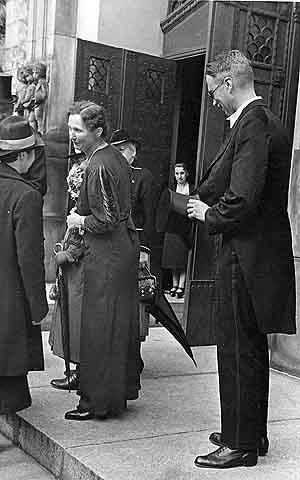
1939,
Breslau, Father and Mother talking to Käthe Schmidt. The
occasion was Eva and Gerhard Hammer's wedding. In our
mother's absence I started - the Twins were excluded - an
underground war against our maid. I broke into the air-raid
shelter and from there attacked the "enemy" in the
house...
|

1939,
Breslau, Father in a Stresemann! I have never before or after
seen him in such formal attire. In 1994 Irmgard Hammer took
me to that church in Breslau where she and Hans had also been
married a few years earlier.
|
-
|

|
1939
or 40, Habelschwerdt, An early photo by Gerda Popp.
Gerda
and I didn't like each other, and I still dislike intensely
being photographed. - Look at the stupid face I pull, and the
glossy smiles of everybody else!
I
only found this picture very recently (Nov 2002) in Gerhard's
childhood picture book, which Anneliese lent me.
|
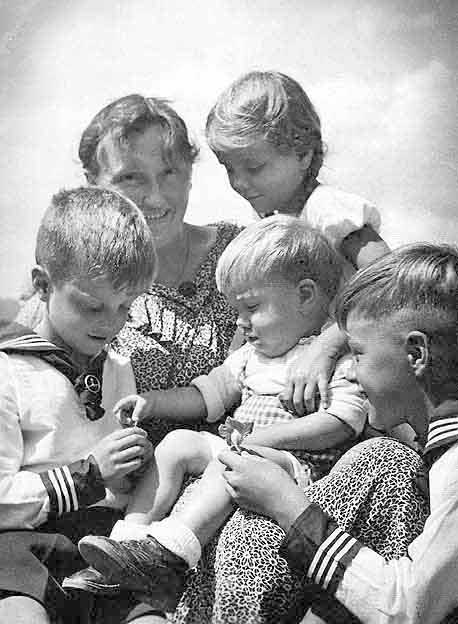
1941,
Habelschwerdt. Gerda Popp took this photo in our garden. Father
dubbed it the "Mutterberg," he was not needed. My beloved
Mother sits surrounded by her four children in this masterfully
constructed arrangement a little left of center and is literally
piled with her children. Little Dieter in her lap. Gerhardchen in a
sailor suit holds a flower in his hand which Dieter is going to grab
in a second. Christine with her braids, the visual summit of the
mountain, looks over Mother's right shoulder, her head in perfect
contrast to Mother's face. All children are concentrating on the
flower in Gerhard's hand. Me, also in a Sunday's best sailor suit,
Gerda has pushed two-thirds out of the picture. I offer a radiating
smile to my siblings and another blossom, a nasturtium from the
flower bed near the house entry - but I am completely ignoreded by
all - including the photographer. Gerda did not like me. - Yet nobody
will see the sibling rivalries that the photographer has so carefully
set in scene. The observer is completely drawn in by Mother's eyes
and her laugh. A strain of hair falling over her forhead, she wears
the dark-blue, unforgotten, silk dress printed with white flowers and
her mother's granat-brooch in her décolleté. This
picture captured one of the most beguiling moments in Mother's life.
|

1939,
Glatzer Schneeberg (Popp)
|

1940,
Schneekoppe in the Riesengebirge (Popp)
|
.
I had become a good skier and Father enjoyed to take me on ever
longer tours. On of the earliest tours was at Easter 1939. We walked
up the Glatzer Schneeberg (1406 m) without skins! The sun was already
qite warm and we lay for a couple of hours on the roof of an shack
behind the Berghaus, an unforgettable experience with snow all around
us. More ambitious were our tours in the Riesengebirge in 1940 and
'41. We wandered along the Kamm, mountain ridge, from Baude
to Baude, simple wooden ski huts for two weeks.
Several
summers during the War years we spent at the Ostsee (Baltic Sea) on
the islands Usedom (1937) and Wollin (1940, 42, 43) Usually together
with our cousins Schmidt (Frankfurt a. O.), Hammer (Köln), and
Stölzel (Gelnhausen). These vacations were wonderful, we staged
wild games, fielded several armies, and plagued our parents. These
weeks are the most precious memories of my childhood. The War was far
away. Except for the dark cloud which Hans Hammer's death on the
Russia front cast over us. The deprevations of the War economy were
substituted by vegetables from our garden. Our childhood in remote
Habelschwerdt was untroubled. No American air raids which threatened
our Hammer cousins in Köln. Father was excepted from the draft,
because he was meanwhile too old and his heart was poor. He had been
given a new, indispensable job, setting up a novel regional planning
division at the agricultural administration in Breslau. It saved his
life..
Our
world collapsed soon thereafter. I became a Pimpf, a cubscout
in the Hitler-Jugend, and soon saw all my idealized dreams of camping
and hiking being smashed by paramilitary exercises. I rebelled and
was demoted and eventually disqualified. A horse kicked my left knee
while helping at a farmer harvest potatoes. My mother confined me to
bed in the winter of 1943-44, which saved me from being trained as a
youth soldier. At Easter of 1944 I was confirmed. I couldn't kneel
because my knee was still swolen.
-
1944,
Habelschwerdt. In the Winter of 44-45 the Russian front had advanced
to within 60 km of Habelschwerdt. We could hear the rumble of heavy
artillery at night. It was then that Father made these "mug-shots"
of the three of us in our Garden with an old ground cloth as backdrop
expecting that they would be the last pictures before the Germany
would collapse - and they were - a year later Mother sold his old
Kodak camera to some Pole in exchange for sugar..... We tried to flee
from the Russian Army
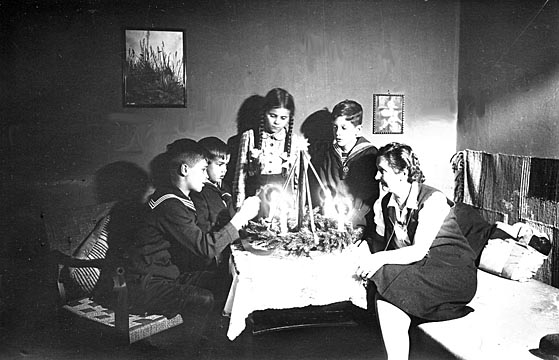
1944,
Habelschwerdt, last Christmas in our house.
In
1943 my school was converted into a military hospital. For a year
there was no school. A week before the End, in May 1945 Father
appeared one night, and we all set out to try to flee from the
advancing Russian armies. We did not get far. Thanks to my Mother's
presence of mind, we returned to our house in Habelschwerdt a week
after we had left - but without Father whom the Russians had taken
prisoner-of-war. I, a tall 14-year-old, was let go.
Habelschwerdt
was now occupied by Russians. To my mother's horror I turned into a
vagrant scavenger stealing abandoned military equipment and other
loot left behind by the German army. In the summer of 45 to protect
my family from marouding Russian and Polish troops - and to get me
off the street - Mother found me an apprentice position, first in a
car repair shop, then as a radio repairman, and finally in a smithy
shoeing horses. In June 1945 Father contracted typhoid in the PW camp
in Glatz and was taken to a German hospital. He miraculously survived
and in August 1945 returned home hairless, weak, and emaciated. We
hid him in Spätenwalde, a village in the mountains.
.
-
|

|
1944-45, Spätenwalde,
Father lived with the farmer at the very top of this
picture. The farm has been destroyed in the 50s and exists
no longer.
|
"Refugies"
in Oldenburg and a New Beginning in Kreuzriehe
1946
- 1999
In
the Fall of 1945 an increasing flow of Poles replaced the Russians,
and by 1946 the situation had become so desparate, that in May 1946
Mother on her knees begged the Polish officials to deport us -
hopefully to a place in the West. For ten days we rode in cattle cars
through burned-out cities and villages - to Lohne near
Vechta/Oldenburg in the British Occupied Zone of western Germany.
But
we were all together! - The next three years as "Refugees"
in and around Lohne were the worst in our and especially in my
parents lives. But Mother insisted that we go to school, barefoot
three kilometers to Dinklage, and later in the winter of 1946/47 ten
kilometers through the snow to the Gymnasium in Vechta.
-
|

|
1950,
Kreuzriehe near Bad Nenndorf
In
1948 Father had found a surreal job with the former Breslauer
Regional Planning Group. - Its director, Prof. Obst, had fled
to Bad Nenndorf near Hannover where he was producing a White
Book on the lost eastern German territories - for the British
Control Commission....! In 1949 we were given an apartment of
our own an entire floor of a former carriage house - without
bath, water, or toilet - in Kreuzriehe, a village near Bad
Nenndorf. Magda donated old furniture. Life was almost normal
again...
The
two large windows were Gerhard's, Dieter's, and my room.
Christine had an alcove to herself on the left, and behind the
little window on the right Father had set up a box with a can
filled with peat moss - our communal toilet....
|
.
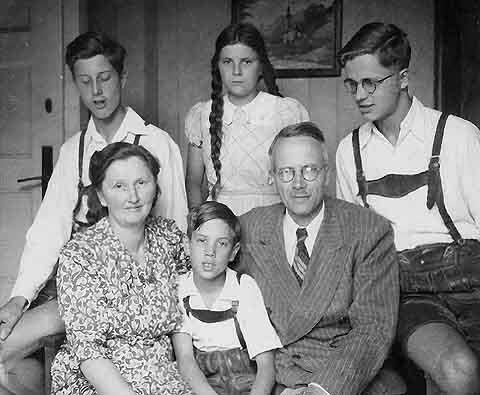
1950
or 51, Kreuzriehe, Gerhard, Christine, Rolf, Mother, Dieter, Father.
Photo by Gerda Popp, who had resurfaced somewhere in Bavaria!

1950
or 51, Kreuzriehe, Mother and Magda Stölzel on her first visit
after 5 years.
In
1947 Mother and I ventured on a bizarre rail-journey through the
ruins of Hannover, across the border between the British and American
Zones to Gelnhausen, where Grandmother Hammer and Tante Gretel
Laffert from Breslau had found refuge in Magda Stölzel's house.
There I fell in love with my cousin Brigitte, who became my closest
confidante and emotional support in the next five difficult years.
Whenever possible I would flee from the frictions at home to
Gelnhausen.
|

1952,
Brigitte Stölzel
|
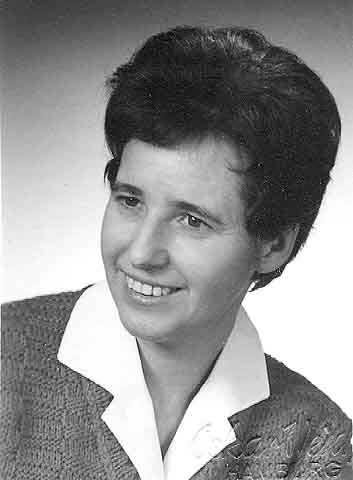
1963,
Irmgard Hammer
|
Another
love of those years was - without her knowledge - Irmgard Hammer, the
beguiling, young, elegant, extrovert aunt of my childhood. Despite
the tribulations after Hans's death and her hair-raising escape with
two small children from the besieged Breslau in the winter of 1944,
despite her son Udo's polymelitis in 1947 and a near-death bout with
tuberculosis in 1951 she remaind the joyous, vibrant woman I adored
since I had staying with her in Breslau in 1938. In the last four
years before her death in 1999 a very close friendship grew between
us. She was the only person who volunteered to accompany me on a
crucial pilgrimage to Breslau, Glatz, and Habelschwerdt in 1994 and
to Pommerania and East-Prussia a year later.
|

Grossmutter
Hammer 1956/57 in Gelnhausen
|
I
passed my Abitur in Wunstorf in 1951 and moved to Göttingen to
study physics. Gerhard followed me to Göttingen a year later. I
met Barbara in Göttingen in 1956 and decided to emigrate to the
USA to finish my doctorate at Harvard - but that is another story, to
be told elsewhere at another time. Gerhard also emigrated to the US
in 1958 to study at MIT. In 1966 Gerhard married Anneliese. They
lived in Ithaca, NY, Seattle, and Los Angeles. He died of a terrible
case of cancer in 1976. Anneliese and their son Peter continue to
live in LA.
After
Father's retirement in 1964 my parents bought a small house in
Gelhausen, where they lived until their death in 1981. I visited them
there, first with Susanne in 1965 and many times thereafter. Another
occasional visitor became Father's sister Käthe Schmidt, who
lived in their parents' house in Frankfurt-an-der-Oder in the GDR-DDR
and could only obtain permission to visit West-Germany with great
difficulties.

1980,
Gelnhausen, Dieter on his last visit to his parents.
Dieter
had been diagnosed with Bechterev in 1962 and by 1980 his spine had
become so stiff that he could only move with difficulty. To this day
he continues to work as a theoretical physicist at the Hahn-Meitner
Institute in Berlin, pushed around in a wheel-chair by his wife
Evelyn. He died miserably in Berlin in 2008 of a liver cancer
By
1980 Father had lost his hearing. We could only communicate with him
by writing notes. Mother became very weary of taking care of him.
Father died in 1981 - and Mother had a brain aneurism a few months
later from which she never woke again. They are buried in the same
grave in Gelnhausen in which Grandmother Hammer and Tanta Gretel -
who died, 98 years old, after her sister - are buried. In 1999
Irmgard Hammer was also laid to rest in the same grave, so that I can
find three of the most important women in my life in one place....
-
.






























































